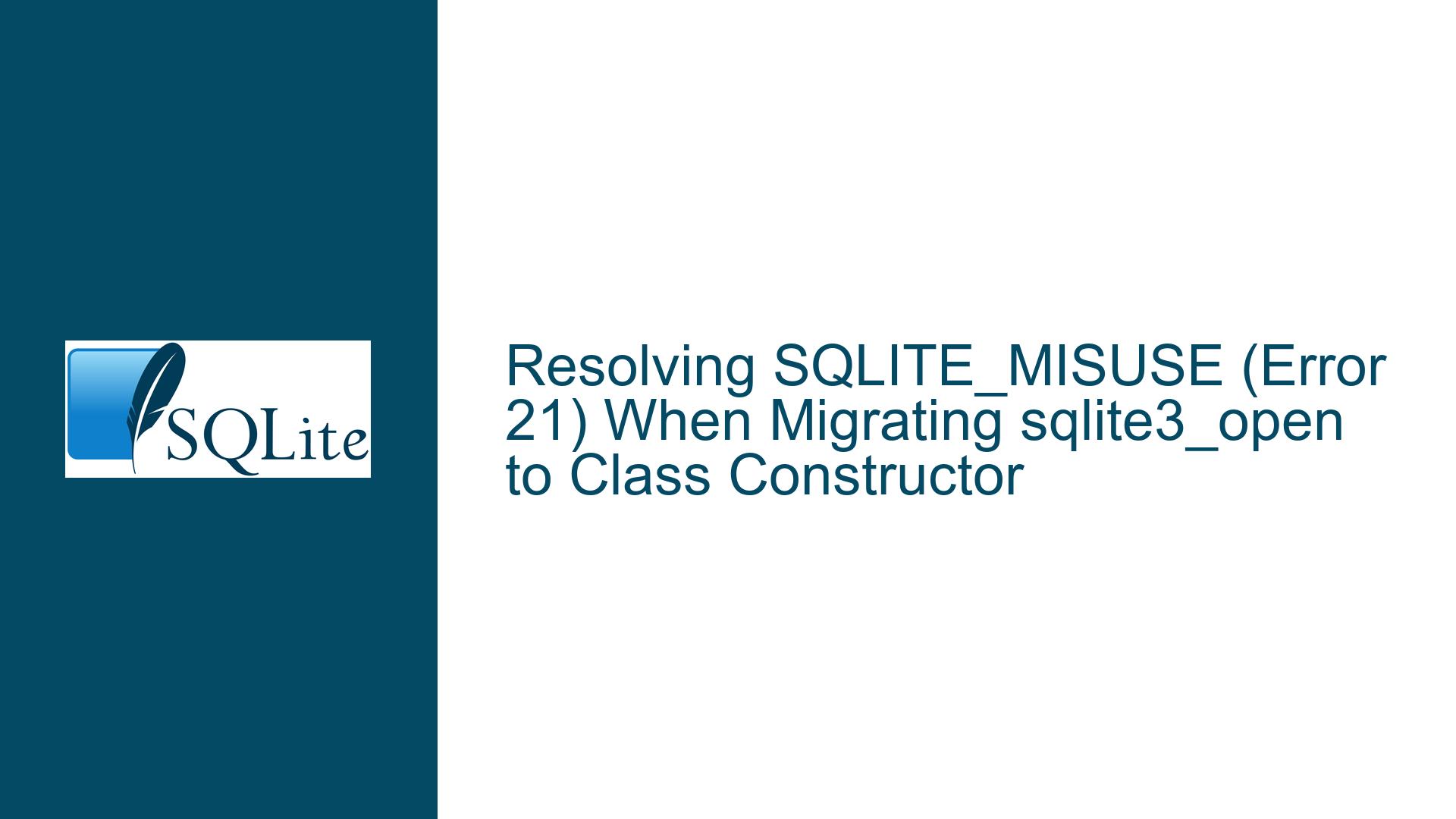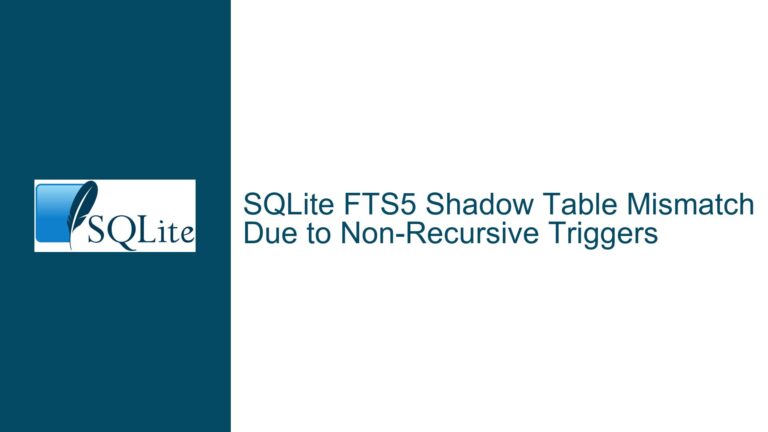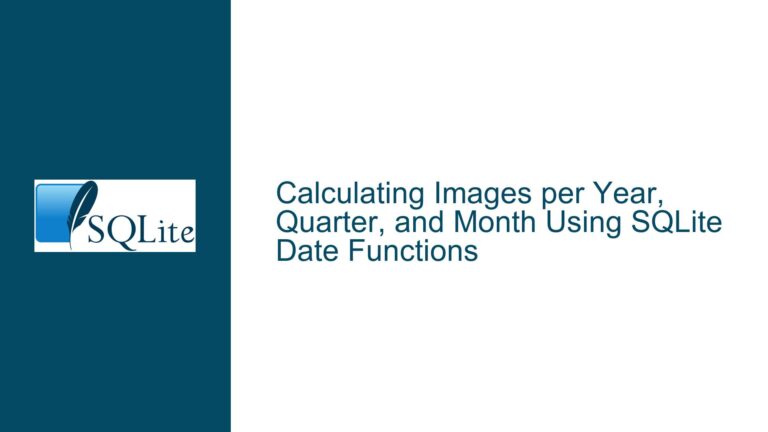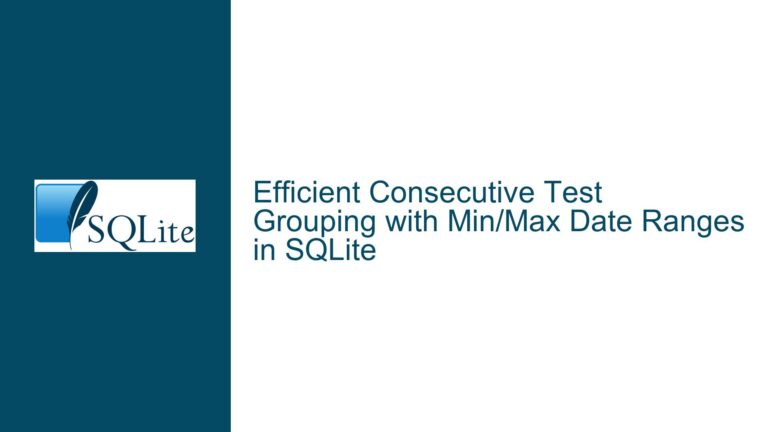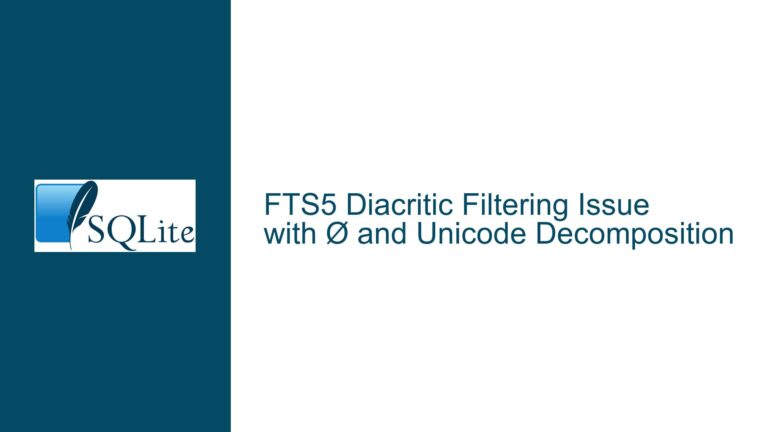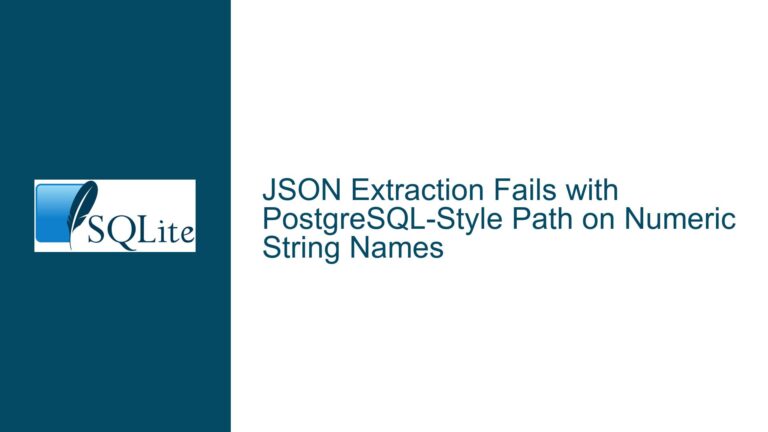Resolving SQLITE_MISUSE (Error 21) When Migrating sqlite3_open to Class Constructor
Database Handle Initialization and Lifetime Management
The core issue revolves around improper handling of the sqlite3* database connection object when transitioning from a procedural code structure to an object-oriented design. The sqlite3_prepare_v2 function returns error code 21 (SQLITE_MISUSE), indicating that the SQLite API was invoked in a way that violates its runtime constraints. This error manifests specifically when the database handle (db) is moved into a class member variable and accessed across different scopes. The root cause lies in subtle mismanagement of the database handle’s lifecycle, initialization sequence, or pointer ownership within the class architecture.
Critical Failure Modes for sqlite3_prepare_v2 in Object-Oriented Contexts
Three primary failure vectors dominate this scenario:
Uninitialized or Stale Database Handle
Thesqlite3* dbpointer stored as a class member may not be properly initialized before being passed tosqlite3_prepare_v2. This occurs if the class constructor fails to assign the opened database connection to the member variable (e.g., due to variable shadowing) or if the constructor is not invoked at all before methods usingdbare called.Invalid Pointer Propagation Across Class Instances
Multiple instances of the class might inadvertently share or overwrite thedbhandle. For example, if the class employs a static or shareddbmember without thread-safe initialization, concurrent access or improper scoping can corrupt the pointer.Premature Closure or Resource Leakage
The database connection might be closed prematurely bysqlite3_closein a destructor or another method beforesqlite3_prepare_v2is invoked. Conversely, failure to close the connection could lead to resource exhaustion, though this does not directly causeSQLITE_MISUSE.
Comprehensive Diagnosis and Resolution Workflow
Step 1: Validate Database Handle Initialization
Inspect Variable Shadowing in Constructor
Ensure the class constructor initializes the member variabledband not a local variable of the same name. For example:// Incorrect: Local variable 'db' shadows the member variable MyClass::MyClass() { sqlite3* db; // Local variable sqlite3_open("path", &db); // Member 'db' remains uninitialized } // Correct: Initialize member variable MyClass::MyClass() { sqlite3_open("path", &this->db); // Explicitly reference member }Use compiler warnings (
-Wshadowin GCC/Clang) to detect shadowing.Verify Constructor Invocation Order
Confirm that the class instance wheresqlite3_prepare_v2is called is the same instance where the constructor initializeddb. If the instance is copied or moved, thedbhandle might not follow due to improper implementation of copy/move semantics.Debugger-Assisted Pointer Inspection
Set breakpoints in the constructor and the method callingsqlite3_prepare_v2. Check the memory address stored indbat both locations. If the address is0x0or differs between breakpoints, the handle is invalid.
Step 2: Enforce Pointer Validity and Thread Safety
Precondition Checks
Before invokingsqlite3_prepare_v2, assert thatdbis non-null:if (!db) { LOG_SYS << "Database handle is null"; return false; }Log the value of
dbto verify it matches the address returned bysqlite3_open.Thread Isolation
SQLite connections are not thread-safe by default. If the class is used across threads, ensure that:- Each thread has its own
sqlite3*instance. - Mutexes guard critical sections accessing
db. - The
SQLITE_OPEN_FULLMUTEXflag is used insqlite3_open_v2for serialized threading mode.
- Each thread has its own
Resource Ownership Tracing
Implement a wrapper class forsqlite3*that logs all operations (open, close, query):class DatabaseHandle { public: sqlite3* ptr = nullptr; DatabaseHandle(const char* path) { sqlite3_open(path, &ptr); LOG_SYS << "Opened database at " << ptr; } ~DatabaseHandle() { if (ptr) { sqlite3_close(ptr); LOG_SYS << "Closed database at " << ptr; } } };This logs the handle’s lifecycle, making it easier to spot double-closes or leaks.
Step 3: Address API Contract Violations
Post-Open Error Checking
sqlite3_openreturnsSQLITE_OK(0) on success. However, even on failure, it may return a non-nulldbhandle. Always check the return code and the error message:int rc = sqlite3_open("path", &db); if (rc != SQLITE_OK) { LOG_SYS << "Error opening database: " << sqlite3_errstr(rc); if (db) { LOG_SYS << "Extended error: " << sqlite3_errmsg(db); sqlite3_close(db); db = nullptr; } return false; }Statement Preparation Sanity Checks
Aftersqlite3_prepare_v2, always check if the statement handle (stmt) is valid before proceeding:sqlite3_stmt* stmt = nullptr; int rc = sqlite3_prepare_v2(db, sql, -1, &stmt, nullptr); if (rc != SQLITE_OK || !stmt) { LOG_SYS << "Prepare failed: " << sqlite3_errmsg(db); return false; }SQL Syntax Validation
WhileSQLITE_MISUSEtypically indicates handle issues, invalid SQL can sometimes trigger misleading errors. Validate the SQL statement usingsqlite3_prepare_v2in a standalone test case.
Step 4: Architectural Refactoring
RAII-Based Database Class
Refactor the code to encapsulate the database connection in a class with strict RAII (Resource Acquisition Is Initialization) semantics:class Database { private: sqlite3* db = nullptr; public: explicit Database(const std::string& path) { if (sqlite3_open(path.c_str(), &db) != SQLITE_OK) { throw std::runtime_error(sqlite3_errmsg(db)); } } ~Database() { if (db) sqlite3_close(db); } // Disallow copying to prevent double-closes Database(const Database&) = delete; Database& operator=(const Database&) = delete; };Explicit Connection Lifetime
Ensure theDatabaseclass instance outlives any objects (e.g., statements, cursors) that depend on it. For example:void foo() { Database db("path"); // Constructor opens connection Statement stmt(db); // Statement uses 'db' handle // ... } // 'stmt' is destroyed before 'db', preventing use-after-closeDependency Injection
Avoid global or static database instances. Instead, pass theDatabaseobject explicitly to dependent components:class LoginManager { private: Database& db; // Reference to externally managed database public: explicit LoginManager(Database& db) : db(db) {} bool validateLogin(const std::string& user) { // Use db.ptr here } };
Step 5: Advanced Debugging Techniques
Memory Breakpoints
Use tools like GDB or LLDB to set a watchpoint on thedbpointer. This halts execution when the pointer is modified:watch -l dbSQLite Debug Hooks
Enable SQLite’s built-in debugging features to trace API calls:sqlite3_config(SQLITE_CONFIG_LOG, [](void*, int code, const char* msg) { LOG_SYS << "SQLite Log #" << code << ": " << msg; }, nullptr);Address Sanitizers
Compile the code with AddressSanitizer (-fsanitize=address) to detect memory corruption or use-after-free errors involvingdb.
By systematically addressing pointer initialization, enforcing thread and lifetime guarantees, and adopting RAII-based resource management, developers can eliminate SQLITE_MISUSE errors arising from class-based database handle management. The key is to treat the sqlite3* handle as a critical resource with strict ownership rules, akin to file descriptors or network sockets.
